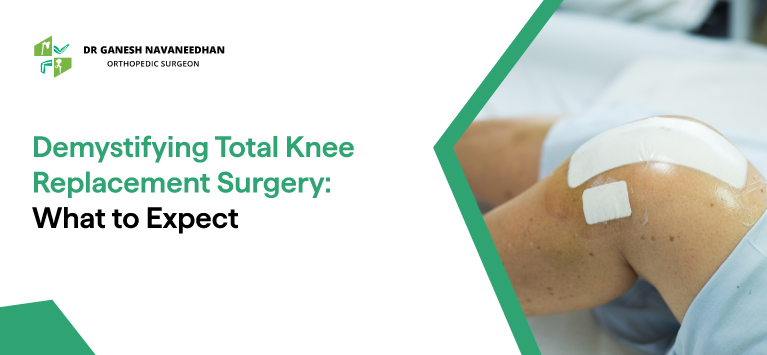- +91 62384 78716 +91 99475 78797
-
Sasthamangalam, Trivandrum
Sasthamangalam, Trivandrum
Table of Contents

In case your knee is severely harmed due to osteoarthritis or an old injury, basic tasks like walking or going upstairs might become hard. There are moments when pain could even be experienced while resting on a bed or chair.
If treatments like pain relief drugs, shots, physical therapy, or crutch use don’t work anymore, doctors might think about complete knee replacement surgery. This surgery is good at easing pain, fixing leg shape issues, and letting you return to daily activities without pain.
Table of Contents
Knee replacement surgery is a proven and secure treatment that deals with long-lasting knee aches. It brings back proper leg positioning and helps in going back to daily tasks without pain. The main reason behind enduring knee unease and limited functioning is osteoarthritis. Especially persistent age-related osteoarthritis, rheumatoid arthritis, and post-injury osteoarthritis are the key usual suspects.
The procedure of total knee replacement involves four fundamental steps:
The decision to have total knee replacement surgery (knee replacement) should be a joint decision between you, your family, your GP, and your orthopedic surgeon. The doctor you see might suggest sending you to an orthopedic surgeon to carefully check you and decide if this surgery could help you.
Several factors might warrant knee replacement surgery, such as:
Knee replacement surgery isn’t restricted by age or weight, but excess weight can affect implant longevity. While most candidates are aged 50-80, the decision is based on pain and disability, not age.
An important factor in deciding whether or not to have total knee replacement surgery is understanding what this procedure can and cannot do.
Over 90% of those who have had knee replacement surgery report a significant reduction in knee pain and an improvement in daily activities. Nonetheless, this procedure will not make you more capable than you were before you developed osteoarthritis.
The plastic part that makes a knee replacement begins to wear down after repeated use. Doing too much or carrying too much weight might hasten the aging process. As a result, your prosthetic knee may need to be replaced sooner than intended if it becomes loose or causes pain. That’s why many physicians advise you to avoid activities like running, jogging, or high-impact sports for the rest of your life following surgery.
Walking, swimming, golfing, driving, hiking, biking, dancing, and other low-impact sports are all acceptable activities after total knee replacement surgery. With appropriate modifications to your activities, your knee replacement can last for many years.
Following a total knee replacement, the chance of complications is quite low. Serious problems, like knee infections, are seen in under 2% of patients. More significant medical issues like heart attacks or strokes are even rarer. The presence of chronic illnesses can heighten the risk of complications. Though not common, if these issues do emerge, they can delay recovery. It’s advisable to talk over your worries with an orthopedic surgeon before the operation.
Infections: Infections can develop within the deep wound or around the denture. They might emerge during your time in the hospital or later when you’re back home. Infections could even surface years post-surgery. Localized infections in the wound area are usually handled with antibiotics. For severe or deep-seated infections, further surgery might be necessary, potentially leading to the removal of the prosthesis. Any infection in your body, even distant from the knee, could spread to the prosthesis.
Blood Clots (Thrombi): Blood clots forming in the leg veins are the most typical issue linked to knee replacement surgery. These clots can turn life-threatening if they break off and travel to the lungs, causing a pulmonary embolism. To prevent this, your orthopedic surgeon might recommend actions like elevating your legs, early leg exercises to boost circulation, wearing support stockings, and taking blood-thinning medications.
Problems with the System: Despite advancements in implant designs, materials, and surgical techniques, the surfaces of implants can wear down, and components of the prosthesis may become loose. Additionally, while an average flexion of 115° in the knee is expected after surgery, sometimes scarring can occur, limiting movement, particularly in patients with restricted motion prior to the procedure.
Persistent Pain: A small subset of patients might experience ongoing pain after knee replacement, and at times, the exact cause can be challenging to determine. This complication is rare; however, most patients report excellent experiences, particularly regarding pain relief, following knee replacement surgery.
Neurovascular Injuries: While very uncommon, injuries to the nerves or blood vessels around the knee can occur during surgery.
In the journey towards total knee replacement, understanding its benefits and potential complications is crucial. This guide has shed light on the procedure’s intricacies, from addressing chronic pain to restoring mobility. Remember, individual experiences can vary, and it’s essential to approach this decision with caution and reliance on medical professionals. Consulting with orthopedic experts can provide personalized insights, helping you make an informed choice tailored to your unique needs. By relying on the guidance of skilled professionals, you can embark on a path towards improved quality of life and reduced discomfort.
Copyright © 2025 Dr. Ganesh Navaneedhan. All Rights Reserved. | Designed By Harvee healthcare